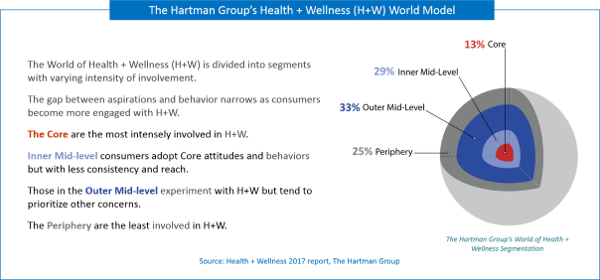Looking for a competitive edge? Imagine the possibilities of health and wellness
 Consumers and food and beverage companies have at least one thing in common: health and wellness is at the forefront of their minds. Industry executives, spanning the broad spectrum of the supply chain, from farm to fork, recognize the transformative power of health and wellness in shaping their business but grapple with how to leverage health and wellness as the foundation for building competitive distinction.
Consumers and food and beverage companies have at least one thing in common: health and wellness is at the forefront of their minds. Industry executives, spanning the broad spectrum of the supply chain, from farm to fork, recognize the transformative power of health and wellness in shaping their business but grapple with how to leverage health and wellness as the foundation for building competitive distinction.
Consumers have been playing in the aspirational lifestyle that we call health and wellness for several decades now. We believe that the health and wellness lifestyle is evolving into something more. Something beyond. Something that accounts for an evolving way of living that eclipses mere health and wellness. We have increasingly come to understand this space as something we refer to as possibility.
Our notion of possibility is about concrete, real-world opportunities to experience and enjoy the highest quality of life (possible). And this quality of life is limited only by one’s imagination.
To see the possibilities means to understand where consumers are today.
U.S. consumers’ awareness of and engagement with their health issues and overall wellness appear to be growing, according to The Hartman Group’s Health + Wellness 2017 report. While, in many ways, health and wellness has always been about food, today’s consumers continue to view food and beverage as the linchpin of health and wellness and increasingly look for the hallmarks of fresher, less processed foods and beverages.
“There is no single type of wellness consumers,” said Laurie Demeritt, CEO of The Hartman Group. “This is a good thing because it means the potential market is far less limited. Instead of a microscopic view on consumers, we’d suggest that the pathway to unlocking potential health and wellness market opportunities lies in taking a broad view into the larger world of wellness to learn how to better serve consumers.”

Wellness Culture Today
The Hartman Group has been tracking consumers’ perspectives and behaviors around health and wellness since the 1990s. In that time, we have seen consumer definitions of health and wellness shift from a rules-based, reactive paradigm to a proactive wellness culture where ideas about what health and wellness is and how to achieve it have broadened to encompass many, if not all, aspects of consumers’ lives.
This includes diet, the ebb and flow of energy, sleep and rest, activity and exercise, mindfulness and emotional outlook, mental health, social engagement, and work-life balance. The concept of balance remains key to how consumers understand and embody health and wellness; when one aspect of their health and wellness grows too big or too small, it affects all the others. Rather than a mechanistic, defensive approach, consumers are more likely today to see health and wellness in a more ecological way, as a system that needs harmony inside and out.
By tracing the beliefs that underlie food and wellness trends, The Hartman Group’s Health + Wellness 2017 report provides the depth of understanding to help food companies align their brands with consumers’ values and more easily predict where shoppers might end up next. We also apply our signature “ahead-of-the-curve” thinking for marketing health and wellness solutions to consumers with our inclusive focus on trendsetters, early adopters and more mainstream consumers. The report delivers a culturally based big-picture assessment of where health and wellness is today, where it is headed and what it means for your business.
About the Report
 The Hartman Group has been leading the study of health and wellness since the early 1990s. Over decades of mapping consumers’ evolving views, aspirations and adoptions, we have become undisputed experts in the field through our unique combination of quantitative rigor and rich ethnographic detail. Health + Wellness 2017 applies this innovative approach to continue our exploration of health and wellness in the U.S. market and culture at large. The report identifies the factors and trends driving demand for healthy foods and beverages as well as other wellness products and services. The report’s findings, insights and recommendations illuminate the emerging opportunities for CPG food and beverage manufacturers, food retailers, food service companies and restaurants, and companies with a stake in the wellness market. EXECUTIVE SUMMARY & ORDER FORM
The Hartman Group has been leading the study of health and wellness since the early 1990s. Over decades of mapping consumers’ evolving views, aspirations and adoptions, we have become undisputed experts in the field through our unique combination of quantitative rigor and rich ethnographic detail. Health + Wellness 2017 applies this innovative approach to continue our exploration of health and wellness in the U.S. market and culture at large. The report identifies the factors and trends driving demand for healthy foods and beverages as well as other wellness products and services. The report’s findings, insights and recommendations illuminate the emerging opportunities for CPG food and beverage manufacturers, food retailers, food service companies and restaurants, and companies with a stake in the wellness market. EXECUTIVE SUMMARY & ORDER FORM
